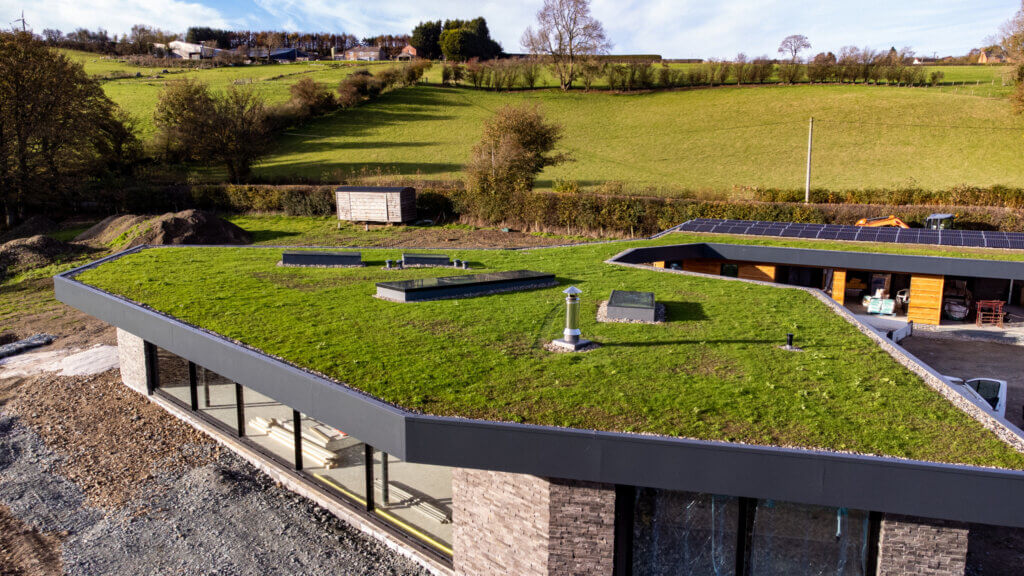Green roofs with solar panels is an innovative technology that’s transforming the way we think about sustainable energy. By combining these two approaches, we can create a powerful synergy that not only promotes environmental conservation but also generates clean, renewable energy.
This article explores the growing trend of integrating environmentally green roofs with solar panels and highlights the benefits they offer. We will also delve into the challenges faced during the integration process and examine real-life case studies that showcase the positive impact of these installations.
Ultimately, this article aims to shed light on the future potential of this technology and its significant role in the transition towards a more sustainable energy landscape.

Benefits of Green Roofs
Green roofs, also known as living roofs or vegetated roofs, offer a wide array of benefits, making them an integral component of sustainable building practices. By integrating vegetation into rooftops, green roofs provide both environmental and societal advantages.
Environmental Benefits:
- Improved Air Quality: Green roofs act as natural air filters, capturing pollutants and absorbing carbon dioxide. The vegetation on green roofs helps to mitigate the effects of urban air pollution, contributing to cleaner and healthier city environments.
- Reduced Urban Heat Island Effect: Green roofs absorb solar radiation and release it back into the atmosphere through evapotranspiration, lowering ambient temperatures. By minimising the urban heat island effect, green roofs help mitigate heat-related illnesses and reduce the demand for energy-intensive cooling systems.
- Stormwater Management: Green roofs absorb rainwater, reducing stormwater runoff and alleviating strain on urban drainage systems. They act as effective retention systems, allowing rainwater to be slowly released back into the environment, reducing the risk of floods, and improving water quality.
- Biodiversity and Habitat Creation: Green roofs provide habitats for various plant species, insects, birds, and other wildlife, particularly in urban areas with limited green spaces. They contribute to urban biodiversity conservation by offering refuge and foraging opportunities for pollinators and other beneficial creatures.
- Noise Reduction: The layers of vegetation on green roofs help to absorb and dampen sound, reducing noise pollution from sources such as traffic and machinery. This can significantly improve the quality of life for residents and workers in urban environments.
Societal Benefits:
- Improved Quality of Life: Green roofs offer numerous psychological and physiological benefits. Access to green spaces and views of nature have been linked to stress reduction, increased productivity, and enhanced mental well-being. Green roofs provide opportunities for relaxation, recreation, and community engagement, fostering a sense of connection with the environment.
- Enhanced Aesthetics and Property Value: Green roofs contribute to the visual appeal of buildings and the overall urban landscape. They can transform concrete jungles into vibrant green spaces, improving the aesthetics and liveability of cities. Green roofs can also increase property values, making buildings more attractive to potential buyers or tenants.
- Energy Efficiency: Green roofs act as natural insulation, reducing heat transfer through the roof and minimising temperature fluctuations within the building. This helps to lower the demand for energy-intensive heating and cooling systems, resulting in reduced energy consumption and cost savings for building owners.
- Extended Roof Lifespan: The vegetation layer of green roofs protects the underlying roof materials from harmful UV radiation, temperature extremes, and physical damage. This protection extends the lifespan of the roof, reducing the need for frequent repairs or replacements.
Green roofs offer a multifaceted range of benefits that contribute to environmental sustainability, human well-being, and urban resilience. As we embrace green roof technologies and integrate them with other sustainable practices, we can create greener and more resilient cities that prioritise the health of both people and the planet.
Benefits of Solar Panels
Solar panels have become a prominent solution in the transition towards sustainable energy by harnessing the sun’s energy and converting it into electricity without emitting harmful pollutants or greenhouse gases. This clean and renewable source of power helps to mitigate climate change, reduce dependence on fossil fuels, and improve air quality. By utilising solar panels, we can significantly decrease our carbon footprint and make substantial progress in combating climate change.
- Cost Savings: Solar panels offer long-term cost savings for both residential and commercial applications. Once installed, solar panels generate electricity at no ongoing fuel cost, reducing or eliminating electricity bills. In regions with favourable solar conditions, solar panels can provide a substantial return on investment over their lifespan, leading to significant savings for homeowners and businesses.
- Energy Independence and Security: Solar panels enable individuals, communities, and organisations to generate their own electricity on-site. This energy independence reduces reliance on centralised power grids and enhances energy security. In cases of power outages or disruptions, solar panels with battery storage systems can provide a reliable source of electricity, ensuring critical functions can continue to operate.
- Minimal Maintenance and Long Lifespan: Solar panels require minimal maintenance after installation. They have no moving parts, reducing the risk of mechanical failures. Routine cleaning to remove dust and debris is typically all that is needed to maintain optimal performance. Moreover, solar panels have a long lifespan, often exceeding 25 years. This longevity, coupled with decreasing costs, makes solar panels a sound investment for long-term energy generation.
- Scalability and Adaptability: Solar panels are scalable and adaptable, making them suitable for a wide range of applications. They can be installed on rooftops, ground-mounted in open areas, or integrated into building materials such as solar tiles or solar windows. Solar panels can power individual residences, commercial buildings, or entire communities, contributing to a distributed and decentralised energy system.
Solar panels have proven to be a versatile and reliable source of clean energy. As technology advances and costs continue to decline, solar panels will play an increasingly significant role in meeting our energy needs while reducing environmental impacts. Embracing solar energy is a crucial step towards a sustainable and resilient future.
Challenges of Integrating Green Roofs with Solar Panels
While the combination of green roofs with solar panels presents exciting possibilities, there are challenges that need to be addressed for successful integration.
One primary concern is the competition for space. Green roofs require adequate sunlight and open space for vegetation growth, which can conflict with the positioning of solar panels. However, with careful planning and design, it is possible to optimise the layout and achieve a balance between greenery and solar energy production.
Additionally, the weight of green roofs may require structural reinforcement to support the added load, necessitating collaboration between architects, engineers, and solar installers. Furthermore, maintenance and access to solar panels may become more challenging when they are installed alongside a layer of vegetation. Regular cleaning and monitoring of panels are crucial to ensure optimal performance.
The Crystal, located in London, is a perfect example of how these challenges can be overcome. Owned by Siemens, this iconic structure serves as a global centre for urban sustainability and is an excellent case study of the successful integration of green roofs and solar panels.
The Crystal’s green roof covers an impressive area of 2,200 square meters and is adorned with various vegetation, including native grasses, wildflowers, and sedum plants. The green roof provides numerous environmental benefits, such as improving air quality, reducing stormwater runoff, and supporting urban biodiversity.
In addition to the green roof, the Crystal incorporates solar panels into its design to generate renewable energy. The rooftop solar array consists of 79 photovoltaic panels, which convert sunlight into electricity. The energy generated by the solar panels is used to power the building’s lighting, heating, and cooling systems, reducing its reliance on grid electricity.
The integration of green roofs and solar panels at the Crystal demonstrates the synergy between these sustainable technologies. The green roof not only enhances the building’s energy efficiency but also contributes to the overall aesthetic appeal and biodiversity of the area. The solar panels further enhance the building’s sustainability by producing clean and renewable electricity.
The Crystal serves as an educational and demonstration platform, showcasing the successful integration of green roofs with solar panels to promote sustainable practices in urban environments. It stands as a testament to the potential of combining these technologies and inspiring future projects in the UK and beyond.
The Future Potential
The integration of green roofs with solar panels holds immense promise for the future of sustainable energy. As technology advances, we can expect improved solar panel efficiency and reduced costs, making this combination even more economically viable.
Innovations such as transparent solar panels, which can be integrated into windows or skylights, offer exciting possibilities for maximising energy generation without compromising aesthetics. Moreover, the integration of green roofs with solar panels can be scaled up to large commercial and residential buildings, as well as urban developments.
As we continue to embrace sustainability and seek innovative solutions, green roofs with solar panels are poised to become an integral part of our future, transforming our buildings into eco-friendly, energy-producing havens. By harnessing nature’s power and ingenuity, we can pave the way for a greener, more sustainable world.
